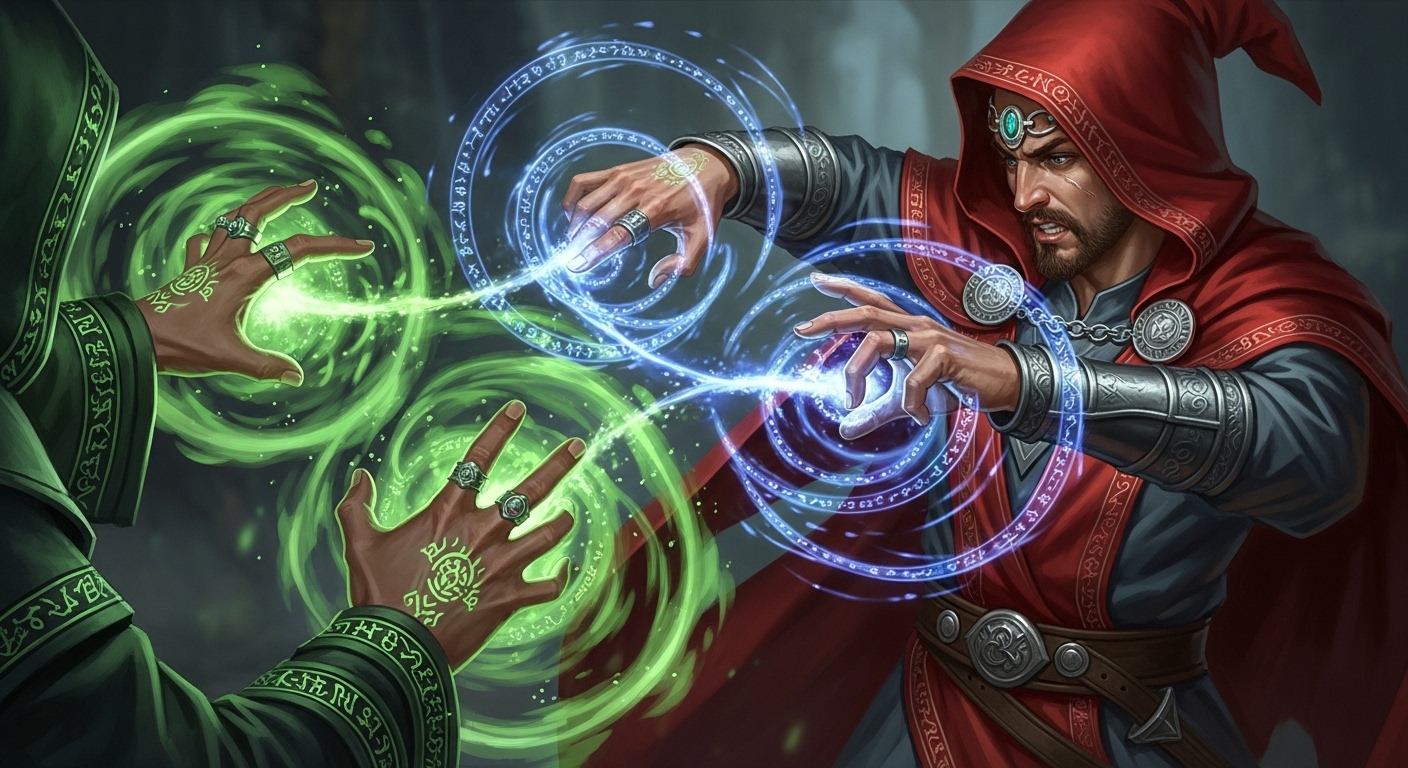Counterspell

- Level: 3
- School: Abjuration
- Class: Sorcerer, Warlock, Wizard
- Casting Time: Reaction, which you take when you see a creature within 60 feet of yourself casting a spell with Verbal, Somatic, or Material components
- Range: 60 feet
- Components: S
- Duration: Instantaneous
You attempt to interrupt a creature in the process of casting a spell. The creature makes a Constitution saving throw. On a failed save, the spell dissipates with no effect, and the action, Bonus Action, or Reaction used to cast it is wasted. If that spell was cast with a spell slot, the slot isn't expended.
Tactical Usage
Spell Disruption Defense: Counterspell provides essential magical defense by interrupting enemy spellcasting. This 3rd-level abjuration spell excels at preventing devastating enemy magic and protecting allies.
Optimal Timing: Most effective against high-level spells, save-or-die effects, or when enemy spellcasters threaten party survival.
Resource Management: Uses a 3rd-level spell slot - available from character level 5+. Reaction timing requires careful positioning and awareness.
Target Selection: Prioritize interrupting the most dangerous spells - area damage, mind control, or game-changing magical effects.
Spell Combinations
Synergistic Spells:
- Detection Magic: Detect magic or identify to understand incoming threats
- Positioning Spells: Misty step or dimension door to maintain 60-foot range
- Reaction Enhancement: Features that provide additional reactions or reaction bonuses
Class Feature Interactions:
- Sorcery Points: Sorcerers can modify counterspell or gain additional spell slots
- Spell Slots: Higher level slots improve success against powerful magic
- Reaction Features: Class abilities that enhance or provide additional reactions
Multi-Caster Coordination: Multiple casters with counterspell can provide comprehensive magical defense coverage.
Material Component Details
Component Acquisition: No material components required - only somatic component needed.
Component Handling: Simple somatic casting allows quick reaction deployment without resource concerns.
Roleplay Opportunities: Different gesture styles reflect magical traditions - dismissive waves, protective wards, or scholarly corrections.
Economic Considerations: No costs make this spell economically viable for frequent tactical use.
Creator Notes
Encounter Balancing: Significantly reduces enemy spellcaster effectiveness. Consider how counterspell availability affects encounter design.
NPC Usage: Enemy spellcasters can counterspell party magic, creating tactical spell slot management challenges.
Environmental Considerations: Requires line of sight and recognition of spellcasting. Stealth casting or cover can bypass counterspell.
Campaign Integration: Essential defensive magic that scales with campaign magical threat levels.
Environmental Interactions
Terrain Effects: 60-foot range requires positioning consideration. Cover and line of sight affect targeting.
Weather Influence: Poor visibility conditions might prevent seeing enemy spellcasting for reaction timing.
Structural Interactions: Walls and obstacles block line of sight necessary for counterspell targeting.
Elemental Interactions: Works against all schools of magic regardless of elemental type or magical source.
Common Rulings & Clarifications
Timing Questions: Reaction triggered when seeing spell with V, S, or M components. Must decide before knowing spell effects.
Target Limitations: Requires line of sight to caster within 60 feet. Cannot counter subtle spells or unseen casting.
Duration Interactions: Instantaneous effect. Successfully countered spells have no effect and waste the action used.
Mechanical Interactions: Constitution save by target. Spell slots aren't expended when spells are countered.
Alternative Applications
Non-Combat Uses: Interrupt harmful rituals, prevent magical pranks, or stop dangerous magical experiments.
Social Encounters: Diplomatic protection against magical coercion, demonstration of magical knowledge, or prevention of magical deception.
Exploration Applications: Stop magical traps from activating, interrupt dangerous magical research, or prevent unwanted teleportation.
Utility Functions: Magical safety enforcement, protection during negotiations, or prevention of magical accidents.
Related Spells
Same School: Other abjuration spells like dispel magic (3rd level remove magic), antimagic field (8th level magic suppression), protection from evil and good (1st level specific protection).
Similar Effects: dispel magic (3rd level remove effects), silence (2nd level prevent verbal), antimagic field (8th level total suppression).
Progression Options: shield (1st level reaction defense), counterspell (3rd level spell interruption), dispel magic (3rd level effect removal).
Complementary Magic: detect magic (identify threats), shield (physical defense), misty step (positioning).
Scaling Analysis
Level Progression: Remains essential throughout campaigns as enemy spellcasters become more dangerous with higher-level magic.
Upcast Benefits: Higher-level casting improves success rates against more powerful enemy spells.
Campaign Phases: Peak utility in mid-to-high level play (5+) where spellcasting becomes tactically dominant.
Comparative Value: Essential defensive magic that justifies spell slot investment through threat prevention.
Narrative Flavor
Casting Description: Swift gestures weave protective magic that unravels enemy spellwork, causing their magical energies to dissipate harmlessly.
Effect Manifestation: Enemy magic flickers and fails as your counterspell breaks their concentration and disrupts their magical flow.
Personal Style: Wizards might use precise arcane gestures, sorcerers channel instinctive magical interference, while warlocks invoke patron-granted disruption.
World Integration: Represents fundamental magical defense available to trained spellcasters, often associated with magical dueling, protective magic, or counter-intelligence operations.